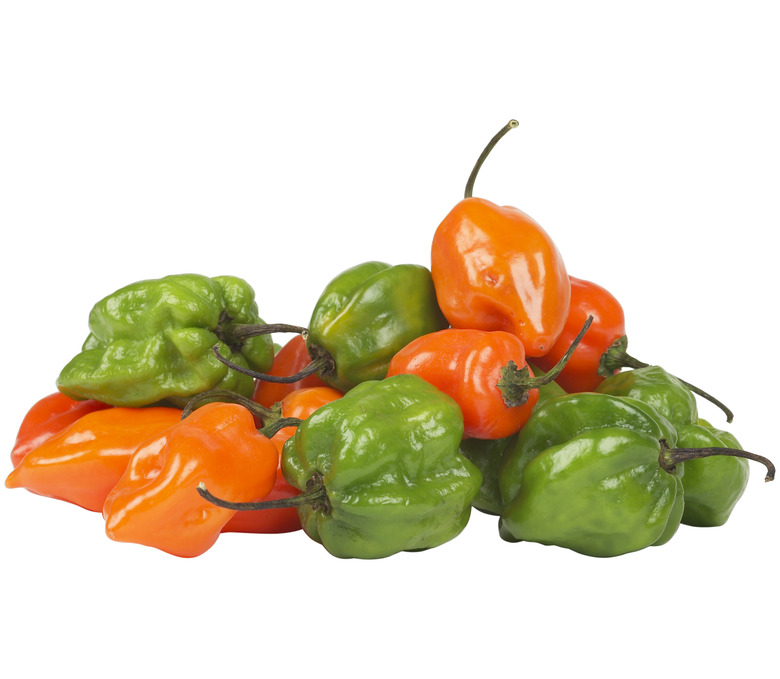Scotch Bonnet Pepper Vs. Habanero
Scotch bonnet and habanero chili peppers are both varieties of Capsicum chinense, a tropical chili species from the Americas. They are among the hottest of all the chili peppers and have a fruity aroma and taste. Scotch bonnet peppers are used in Jamaican jerk sauce and to spice up Caribbean cuisine, while habaneros are typically used to make bottled chili sauce.
Origins
The Scotch bonnet chili is originally from Jamaica, while the habanero pepper hails from Mexico. The ancestors of both Scotch bonnet and habanero peppers were first eaten over 7,000 years ago in South America and first domesticated 5,000 years ago.
Heat
Habanero chili peppers can be up to 445,000 Scoville Heat Units, or the scale used to measure heat in chili peppers, while Scotch bonnet peppers reach 260,000 units. These measurements make them amongst the hottest chili peppers ever recorded. The hottest chili pepper, the "Infinity Chilli," comes in at over 1,000,000 Scoville units, according to a 2011 report by the BBC.
- Scotch bonnet and habanero chili peppers are both varieties of Capsicum chinense, a tropical chili species from the Americas.
- The Scotch bonnet chili is originally from Jamaica, while the habanero pepper hails from Mexico.
Appearance
Habanero chili peppers are box- or lantern-shaped with smooth, glossy skin. They ripen from green to yellow, orange, red or even white and can grow up to 2 1/2 inches long and 2 inches in diameter. The Scotch bonnet measures 1 1/2 inches in length and diameter and has four defined lobes at its base, giving it a bonnet shape. Ripe Scotch bonnets can be red, orange or yellow.
Cultivation
Capsicum chinense peppers, such as the habanero and Scotch bonnet, require minimum temperatures of 55 degrees Fahrenheit. They thrive in free-draining, fertile soil and a sunny location. Chili plants grow well in the garden or as container plants on a sunny windowsill. Do not plant them in soil that has previously held closely related tomatoes, potatoes or eggplants, as this can encourage disease.
- Habanero chili peppers are box- or lantern-shaped with smooth, glossy skin.
- Do not plant them in soil that has previously held closely related tomatoes, potatoes or eggplants, as this can encourage disease.
Scotch Bonnet Plants
Most hot peppers and bell peppers belong to the species Capsicum annum. Scotch Bonnets and peppers that resemble them, such as habeneros, belong to the species Capisum chinense. Peppers are part of the nightshade family and are related to tomatoes and potatoes. Since the plants are related, they face the same diseases. If you are planting from seeds, the soil needs to be at least 76 degrees. Scotch Bonnets like soil that is neither too acidic nor too alkaline. A pH between 6 and 7 is ideal. Acidic soil can also cause blossom end rot. The best course of action is to remove any plants that appear infected and control for aphids.
- Most hot peppers and bell peppers belong to the species Capsicum annum.
- The best course of action is to remove any plants that appear infected and control for aphids.
References
- Florida A&M University: Exploring New Opportunities For Scotch Bonnet Hot Pepper
- BBC News: Record-Breaking Chilli Is Hot News
- New Mexico State University: Growing Chiles in New Mexico
- Missouri Botanical Garden: Capsicum Chinense
- University of Graz: Chile – Capsicum Frutescens L. and Others
- Virginia Tech Research Hot Pepper Industry Rescued from 'Viruses of the Caribbean'
- University of Delaware: Vegetable and Root Crops from Around the World
- Iowa State Extension: Peppers
- North Dakota State University: From Garden to Table, All in the Family
- AVRDC: Tobacco Etch Virus
